Virtually all people who apply to work in the mines, must hold an Australian HR (heavy rigid) licence, this would be equivalent to the HGV class 2 licence here in the UK, as such it was essential for Michael to obtain one if he wanted to pursue his dream of working in the mining industry down under. After a 9 week wait, Michael took and passed the test, which enabled him to apply for the so called FIFO work, (fly in fly out). Michael was very lucky once again, as within a week of applying for work he was offered a start by well known mining and civil’s outfit Leighton’s. A week of Rio Tinto inductions ensued, after which Michael was flown up from Perth to Paraburdoo, which was roughly a 1hour 45 minute flight. This was followed by a 1 hour bus journey through the arid Pilbara countryside to the work camp of Marandoo, which is home to around 1000 workers, various other civil’s contractors, and mine staff. 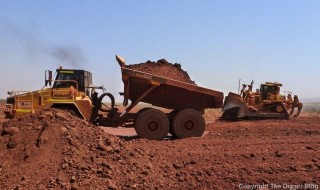
Apart from the actual mine staff, all contractors up there in the construction phase work a roster of 4 weeks on, followed by one week off. During the 4 weeks, Michael only had 2 Sundays off. Most days consisted of a 4.45am alarm call, breakfast at 5.15am, followed by a bus trip to the mine at 6am, to start work at 6.30am and onwards until the end of the shift at 5pm. As one can imagine, it is a hot place to work and according to Michael, even at night it remained in the late 20’s to 30 degrees. During the day at work it was over 40 degrees, and notably reached 44 degrees during one of his shifts, so good working air conditioning is extremely important. 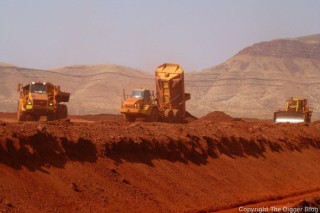
Leighton’s had already been on site for over a year, developing the mine during its phase 2 expansion. The works had included new workshop pads, drainage systems, roadway construction, ore process plant earthworks, and they were now just 12 weeks away from completing a new 500,000 cubic litre tailings dam. Michael’s job was to help out with the batters, and place 300mm stone capping on the inside of the dam walls to prevent storm water erosion. Michael was told that Pilbara only has 2 seasons, wet and dry, and in the wet it absolutely lashes it down, which can lead to torrential flooding in the area. Michael’s first machine on the jobsite was this Hitachi 350, fitted with a tilting grading bucket. The job involved making a temporary bench to gain more reach to place the stone and then working his way backwards. 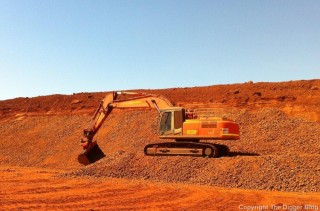
During construction of the dam, Leighton’s deploy a lot of dozers to push the waste overburden downhill, most of this waste had come from earlier sections of the mine and had been tipped there about 8 years ago. This material was “conditioned” by 4 Cat 740 water bowsers, that sprayed water behind the dozers ensuring that the material was moist and ready for the loaders at the bottom of the push. It was then loaded onto 40 ton ADT’s, which hauled and placed the material where it was eventually formed by a combination of Cat D7R, D8T, and D9T dozers which were fitted with GPS systems. 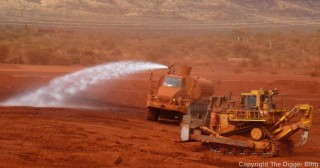

The Caterpillar dozers involved in the big push down from the “borrow pit” included 1 x D10T, 5 x D9T’s and a D9R. The material was loaded onto the trucks by 3 Komatsu WA500’s and 2 Cat 980’s. The articulated hauler fleet consisted of 10 x Komatsu HM400’s and 5 Cat 740’s. 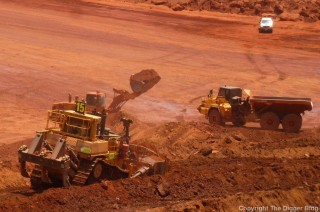
Good haul roads as we know are always essential in the muckshifting game, and as ever the motor grader was the ADT’s best friend, with a pair of Caterpillar 16G’s in attendance keeping things running smoothly. 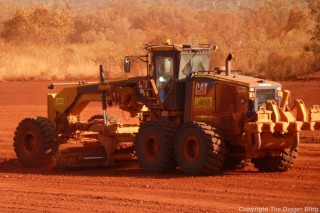
Here we see the view from Michael’s cab, the stone was placed “by eye” to speed up the operation. The vastness of the job made it feel like a daunting task when Michael was told he would be placing the stone all the way around! Michael said a huge amount of stone was used, all of which had been crushed and resized onsite. 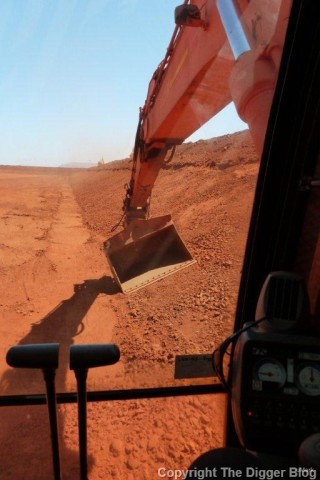
There are many more photos from Michael’s adventures down under, which I will share with you in the New Year.

